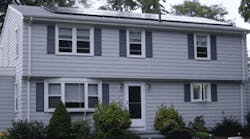FAIRHAVEN, MASS. — Eight years ago, Gary Lavalette, a mechanical contractor and owner of Dartmouth-based Gary's Plumbing & Heating Co., began utilizing sustainable systems in his home to learn more about these technologies and also cut down on utility costs. He started with a wood-burning kiln in the backyard, then solar tubing, next he purchased alternative-fuel vehicles. His most recent sustainable ventures include a solar photovoltaic system and a fuel-cell prototype for a vehicle.
“I looked at my biggest utility bills and worked my way to the smallest utility bills,” explained Lavalette. “My first issue was with the heating of the house. I went out and bought a kiln to cook wood in at a high temperature, turning it into a charcoal briquette. Then I burn the gas from the charcoal briquettes and that gets piped into the house, that’s how I heat the house.”
Heat is transferred from outside to inside the house via a heat exchanger with circulators and valves, located in the house’s basement.
“This [heat exchanger] blends two fluids together, touching but not mixing the water together,” said Lavalette. “The fluids stay apart as the outside unit has its own water system. It’s complex, but works perfect.”
According to Lavalette, by using this 18th century technique, first used to make pottery, he has cut his heating bill tremendously. The wood burning system is used October through April, and is the primary source for heat and hot water during these cold months.
“When I started using this system, I went from $2,200 to $2,300, and now my heating bill is less than $100 dollars,” said Lavalette. “That’s a massive savings.”
Lavalette monitors the kiln via a gauge system in the basement. In the future, he plans to build a gauge system monitor for all the sustainable systems in the house, which he plans to locate in the TV room.
The next sustainable product Lavalette installed was solar evacuated tubes on the house’s roof, so he could heat water in the summer months, from April to October, and not use the kiln. The solar tubes heat approximately 80 gallons of water for two days. A JetGlas water heater tank stores water.
“These are evacuated solar tubes that are vacuum sealed with an oil resin that heats a manifold that heats hot water for the house,” explained Lavalette. It’s like flat panels that were made years ago, however, these are more efficient and made for cold weather applications, so they work a lot better.”
Once Lavalette had the solar evacuated tubes installed, he decided he wanted to heat the swimming pool as efficiently as possible. Thus, he used the solar evacuated tubes for this too.
“I was able to extract heat off of the roof, using the solar tubes,” said Lavalette. “Now we can use the pool for five months instead of three. In New England weather fluctuates quite a bit, so we need hotter water, especially at night. We usually keep the pool at 90ºF.”
The next sustainable venture for Lavalette was purchasing alternative-fuel vehicles.
“Because of the spike in gas prices at the time, I bought my third hybrid vehicle,” said Lavalette. “I have a new Ford Fusion hybrid that gives me 700 miles to a tank of fuel or 55 miles to a gallon.
“I fill it up every six weeks,” he continued. “It does everything a full electric car does. Plus it charges itself, so you don’t have to plug it in. This car goes 47 mph on electric and after you exceed the 47 mph, the gas engine supplies you with enough power, so you can go as fast as you can or want.”
Lavalette drives a Ford Fuel-Flex diesel truck for work that also burns biodiesel.
“I’ve experimented with using fryolator waste and corn oil, however, it didn’t go as well as expected,” said Lavalette.
According to Lavalette, the main problem when using corn oil is that it gels during colder months, but it can be used during summer months when the oil is much thinner.
Recent projects
One of Lavalette’s most recent projects is a 5,200 Watt solar system by SunPower Corp., San Jose, Calif., consisting of 24 SunPower 230 solar panels installed on the home’s south facing roof. Utilizing 72 all back-contact solar cells, SunPower 230 panels deliver a total panel conversion efficiency of 18.5%. The photovoltaic system comes with a monitoring system, which tracks how much energy has been produced, which can be viewed online when away from the house.
Lavalette received a grant from Massachusetts Renewable Energy Trust (MRET) for his solar system installation.
In November 2009, the MRET consolidated with the Massachusetts Clean Energy Center. The Massachusetts Clean Energy Center awards grants for studies and the design and construction of solar panels, wind turbines, hydroelectric systems and other clean energy systems, making renewable energy a reality for citizens and organizations throughout the state.
According to Lavalette, the solar installation is a $42,000 system and out of pocket he spent $8,200, which will be paid for in about two and a half years.
“For people who qualified [for the solar grant], they gave you a $20,000 check from MRET, then they gave you $10,000, plus a dollar for every three watts, so you are just under $35,000 in rebates, but the rest is out of pocket and you can get some back in tax credits,” explained Lavalette.
On Sept. 24, 2009, the home went off-grid, and since then Lavalette has made $2,300 dollars.
“This [solar system] by far, everyone should do,” said Lavalette. “It’s absolutely incredible.”
“The whole idea of doing this [installing sustainable systems] is that people can do alternative energy without spending a lot of money, they don’t have to spend as much as I have,” he added. “People can make a small impact in their lifestyles by using some of the new technologies out there, such as control valves, timers and point-of-use systems that save money. You can do small improvements that can make a big difference. There are also tax incentives and rebates for people who want to do this.”
At this time, Lavalette is also looking into water conservation systems. He is interested in graywater systems, taking shower and laundry water and purifying it to be used to flush toilets. However, according to Lavalette, Massachusetts is very strict regarding these systems and new regulations are coming out now.
“The graywater system has to be designed by a licensed engineer, according to the state, so right now it would cost me too much money to do this,” said Lavalette. “But we do use well water for gardens, and we collect rainwater too.”
Lavalette is also researching and developing a fuel-cell prototype for a vehicle.
“The problem right now is that it takes more energy to extract hydrogen out of water than the actual energy that is produced, but when you are in a car you have a generator and a battery, so you have an endless supply of energy, so why not use that to extract the hydrogen out of water,” explained Lavalette.
Invest in yourself
Lavalette insists that investing in yourself is one of the most important things anyone can do, contractors and consumers alike.
“When the economy went down I had to find a new avenue for work and what I was doing on the house fell right into the picture,” said Lavalette. “I thought that what I’m doing to my house and with vehicles other people would like to do. You would think more people would pick up on this.
“I tell people to keep investing in yourself,” added Lavalette. “What ever money I saved on the project I kept reinvesting. It’s a snowball effect. The $2,000 I saved on heat I paid for the solar tubes with. Right now, the electric company owes me $170, so that money will be invested into something else in the house. That’s they way I look at it. I keep reinvesting money to become more efficient and green.”





